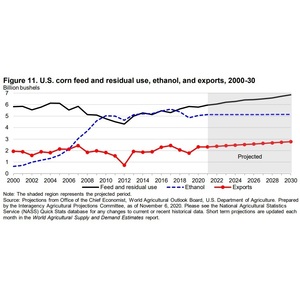USDA predicts 0.5% growth in corn use for ethanol through 2030

February 22, 2021
BY Erin Voegele
The USDA predicts that corn use for ethanol will remain relatively flat, increasing by 0.5 percent over the next decade, according to data released by the agency in February as part of its long-term agricultural projections through 2030.
The agency said ethanol exports are assumed to account for a small but growing share of ethanol consumption through 2030. Total ethanol consumption is assumed relatively stagnant due to gradually declining motor gasoline consumption. Ethanol imports are projected to remain mostly flat.
Corn use to produce ethanol is expected to continue to be a substantial source of demand for the sector, accounting for about one-third of total U.S. corn use through the projection period.
Advertisement
The USDA said underpinning its projections are expected declines in overall gasoline in the U.S. The agency said the U.S. is not projected to return to annual gasoline consumption levels seen prior to COVID-19, although there is expected to be an increase from 2019-’20 levels. Additionally, the USDA said the assumptions project the 10-percent ethanol “blend wall” remains in place, constraining domestic ethanol use over the next decade.
Most gasoline sold in the U.S. is expected to continue to be an E10 blend. According to the USDA, some growth is projected in E15 early in the projection period, but infrastructure and other constraints are expected to limit growth over the long term. The E85 market is expected remain small.
Globally, full recovery in ethanol-gasoline demand to pre-pandemic levels in 2021 is not expected. In most countries, fuel ethanol decline and recovery is expected to mirror changes in gasoline pools where it is blended.
Advertisement
Longer-term, the USDA said global biofuel production and consumption is expected to increase further, though at a slower pace than in recent years. Higher growth rates for renewable diesel and sustainable jet fuel (SAF) are expected.
Brazil is expected to drive much of the global production expansion of fuel ethanol, the USDA said. The U.S., however, is expected to remain the world’s leading exporter of ethanol, with Canada and Brazil expected to remain leading importers. Blending goals for ethanol in China and India are projected to remain unfulfilled.
A full copy of the report can be downloaded from the USDA’s website.
Related Stories
The USDA on April 14 announced the cancellation of its Partnerships for Climate-Smart Commodities program. Select projects that meet certain requirements may continue under a new Advancing Markets for Producers initiative.
The governors of Iowa, Nebraska, South Dakota and Missouri on April 10 sent a letter to U.S. EPA Administrator Lee Zeldin urging the agency to set higher Renewable Fuel Standard renewable volume obligations (RVOs).
President Donald Trump on April 8 issued an executive order that aims to protect oil, natural gas, coal, hydropower, geothermal, biofuel, critical mineral, and nuclear energy resources from state overreach.
Growth Energy, Clean Fuels respond to oil industry in case pushing EPA to reallocate lost biofuel gallons
Growth Energy and Clean Fuels Alliance America on April 14 filed a reply brief in a case challenging the U.S. EPA for its failure to reallocate gallons lost due to SREs granted after RVOs have been issued under the Renewable Fuel Standard.
The Michigan Advanced Biofuels Coalition and Green Marine are partnering to accelerating adoption of sustainable biofuels to improve air quality and reduce GHG emissions in Michigan and across the Great Lakes and St. Lawrence Seaway.
Upcoming Events










